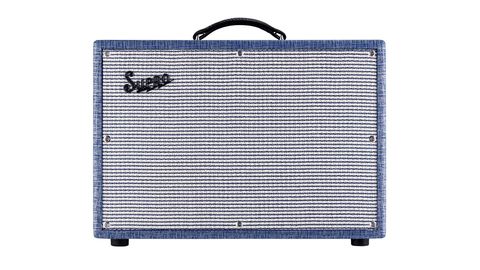The revitalised Supro brand continues to excite vintage enthusiasts all over the world, as Abasara Audio releases more products to tempt us with.
Supro's heritage is one of the most coveted, associated with many blues legends, not to mention its associations with Jimi Hendrix prior to the Experience, and Jimmy Page, whose use of Supro amps and Danelectro guitars to record many early Led Zep tracks adds significant mojo to the badge.
Today, we're taking a look at the low-powered Saturn Reverb. Designed with input from Fender Custom Shop legend Bruce Zinky - who was responsible for keeping the Supro brand alive before Absara - the Saturn is a vintage-styled single-channel design without modern amenities like effects loops or master volumes. There are controls for volume, bass and treble, speed and depth for the built-in tremolo circuit, and a level control for the built-in spring reverb.
"The small components are mostly held on a pair of very high-quality PCBs, with a smaller board for mains and standby switches."
It is a pure valve design, with nothing other than resistors and capacitors in the circuit. The small components are mostly held on a pair of very high-quality PCBs, with a smaller board for mains and standby switches. The preamp board holds the control panel knobs and three horizontally-mounted 12AX7s, while the output stage board's valve sockets face downwards. There's a good deal of wiring between these two boards, which all looks tough enough to handle any amount of live stage work. It's also twisted to reduce hum and properly tied together to stop any handling noise.
Feel and Sounds
In common with all valve-rectified amps, the Supro needs a few minutes to warm up properly before the voltages stabilise. Thanks to high-quality metal film resistors and orange drop capacitors, background hum and hiss is practically nonexistent, which makes the amplifier here for low-volume home use and recording.
We picked a variety of different instruments to check out the Supro's sonic chops, including a '72 Les Paul Custom, a Fender Custom Shop Stratocaster, an old Strat powered with Duncan Alnico Pro IIs and an old PAF-loaded Les Paul Standard.
"Turn your guitar's volume control down, and the amp cleans up nicely, with rich clean sounds and a sugar-sweet treble."
The Saturn uses a pair of 6973 valves in Class A mode, the classic Supro output stage, driving a single 12-inch Supro-branded loudspeaker. The Saturn's pair of valve-rectified 6973s generates around 15 watts, but when coupled to a very efficient modern loudspeaker, that's plenty for live gigs.
The overdrive is mostly output stage-generated and starts to happen at the halfway mark on the volume controls. The Saturn has the classic Supro tone, warm and sweet when played clean, with a subtle mid edge that sits roughly halfway between tweed and blackface tonality. It's very touch-sensitive with a distinctive bite when you dig in.
Turn your guitar's volume control down, and the amp cleans up nicely, with rich clean sounds and a sugar-sweet treble.The reverb and tremolo effects works really well - a warm reverb tail with a long smooth decay, and a generally smooth tremolo.
This amp is unmistakably Supro. It's hard to take that least definable amp characteristic - feel - and transfer it from the classic circuits of the 1960s into a brand new design, but Absara and Zinky have done a stellar job.
Aimed mostly at vintage-amp purists, there are no modern concessions, but effects users will be pleasantly surprised at how good their pedalboards sound plugged into the front- panel input. Drive pedals work really well - we tried a few different ones from both ends of the price spectrum and were very impressed with the results. The prices are on the high side, but remember that these amps are USA-designed and made, with plenty of boutique credibility.

